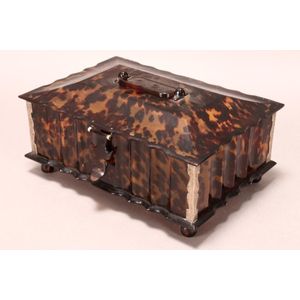Edwardian Lucite jewellery casket, in tortoiseshell finish, the…
Edwardian Lucite jewellery casket, in tortoiseshell finish, the box of rectangular scalloped form with slightly domed cover and handle, with silverplate hardware to corners, on four turned feet, 12 cm x 25 cm x 17.5 cm
You must be a subscriber, and be logged in to view price and dealer details.
Subscribe Now to view actual auction price for this item
When you subscribe, you have the option of setting the currency in which to display prices to $Au, $US, $NZ or Stg.
This item has been sold, and the description, image and price are for reference purposes only.
- Lucite - Lucite was invented in 1931 by chemists at DuPont. It was crystal clear, resistant to water and UV rays, and was low density yet stronger than previous plastics. Like Bakelite, Lucite was used extensively in war supplies during WWII.
After the war, the plastics were used for jewellery and other items. Lucite rings were highly popular during the '50s and '60s, as were Lucite handbags. In 1993, DuPont sold its acrylic resin operations, and the Lucite name now belongs to Lucite International in Southampton, UK. - Edwardian - The Edwardian period of English furniture and decorative arts design is named for Edward VII (1841 ? 1910) who was King of the United Kingdom and the British Dominions and Emperor of India for the brief period from 1901 until his death in 1910. It follows the Victorian period, in turn was followed by the Art Nouveau and Art Deco styles. In Australia, designs of this period are also known as being in the Federation style.
- Tortoiseshell - Tortoiseshell is a translucent material that comes from the horny carapace of a certain types of turtles, including the hawksbill turtle. It is often therefore mounted on a colour underground - often red - or inlaid with gold or silver thread, as seen in Boulle furniture.
The texture and colour nuances of the material are extremely important. Heated tortoiseshell can easily be formed into various shapes. Like other natural materials, tortoiseshell becomes more beautiful with use. In a time before plastic, tortoiseshell was widely used for small objects such as combs and powder compacts.
In 1973, the trade of tortoiseshell worldwide was banned under CITES (The Convention on International Trade in Endangered Species). Prior to importing or exporting items containing tortoiseshell a CITES permit must be obtained. Tortoiseshell items cannot be traded on Ebay.
"Faux tortoiseshell", another case of man initiating nature, is made from old-style plastics such as celluloid and cellulos and is coloured with red, yellow and brown spots to imitate the genuine article. It is commonly used in glasses frames, musical instruments and costume jewellery.
This item has been included into following indexes:
-
boxes, material or decoration
- other materials 189
- tortoiseshell boxes 199
